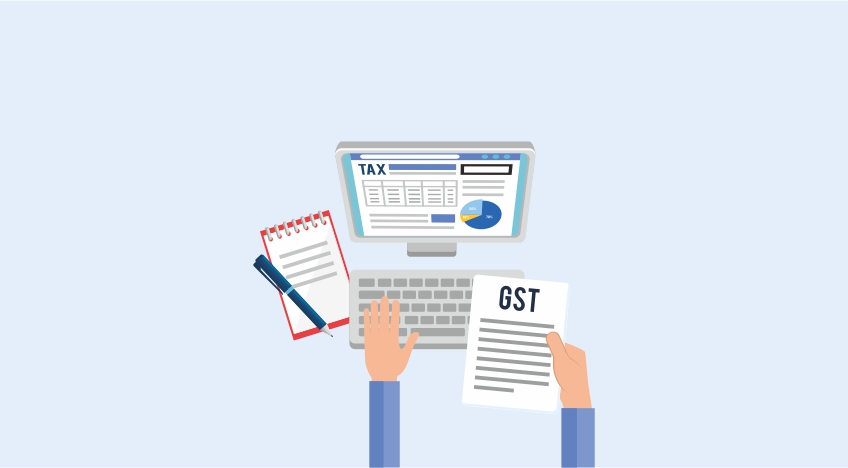GST Accounting – How to Pass Entries under GST?

The Goods & Services Tax (GST) has been implemented in India since 1st July 2017. Since then, the GST Council has been working to simplify the rules to make it easier for businesses. Goods & Services Tax Law in India is a comprehensive, multi-stage, destination-based tax that is levied on every value addition.
In simple words, Goods and Service Tax (GST) is an indirect tax levied on the supply of goods and services. This law has replaced many indirect tax laws that previously existed in India.
Click here to know more about GST.
Prerequisites for maintaining records and accounts under GST accounting
Section 35 of the GST Act explains the record-keeping requirements for businesses to stay tax compliant. In April 2017, the central government also released draft rules for GST accounts and records (draft record rules), which lists additional GST accounting and record-keeping requirements.
- The business owner or the operator of the premises used for storage of goods should maintain accounts during the time in which the goods were in the storage location. This includes details regarding dispatch, movement, receipt, and disposal of goods
- The transporter of goods and services should maintain records of the goods transported, delivered, and the goods stored in transit by them
- Under the GST regime, all the records and accounts should be maintained at the primary place where all the business transactions occur. In case more than one place of business is mentioned in the registration certificate, records and accounts related to each place of business should be kept at the respective workplaces
- If the records are being maintained electronically, business owners should ensure proper back-up of the records/accounts. Also, all records must be ready to be produced, whenever demanded
- When the turnover of a business exceeds the prescribed financial limit, the business is liable for an audit.
Every business owner registered under GST must maintain the following records:
- Production or manufacture of goods - Details of all the goods manufactured or produced by the taxpayer
- Details of purchases - Details of all the inward supplies purchased by the taxpayer, including the name and address of the supplier
- Details of sales - Details of all the outward supplies sold by the taxpayer, including the name and address of the buyer
- Stock of goods - The current amount of goods available in the taxpayer’s inventory
- Input Tax Credit availed - The value of Input Tax Credit availed during the purchase of raw materials or other capital goods
- Output tax payable - The output tax payable on the sale of finished goods or services
- Output tax paid - The GST paid either by availing of input tax credit or in cash
- Any other records if required - Any additional record required by the Government for a particular business type, such as:
- Goods or services imported or exported during a tax period
- Inward and outward supplies that attract the payment of tax on reverse charge, along with relevant documents such as invoices, bills of supply, delivery challans, credit notes, debit notes, receipt vouchers, payment vouchers, refund vouchers and e-way bills.
Accounts to be maintained under the GST regime
It is crucial for every business owner to maintain the following accounts:
- Account of stock with respect to the goods purchased and sold. This account should contain all the related details like opening balance, amount of goods received and supplied, goods lost/stolen/destroyed/written off as gift or free samples, balance stock of raw materials, finished goods, scrap, and wastage
- Account of advances received and paid, along with adjustments if any
- Account of tax amounts, which contains details of tax payable, tax collected and paid, input tax, input tax credit claimed (along with tax invoice as proof), credit note, debit note, and delivery challan (issued or received during a particular tax period)
- Supplier details containing the name and address of the supplier from whom taxable goods/services, have been received
- Recipient details containing the name and address of the buyer to whom goods/services were supplied
- Address of the warehouse/garage or any other premises where the goods are stored. This includes goods stored during transit, along with the details of the stock stored at that instance
- Monthly production accounts, where the quantitative details of the following are furnished:
- raw materials used for manufacture
- goods manufactured
- waste and by-products produced in the process
- Accounts containing the quantitative details of goods used in the provision of services, details of input services utilised and the services supplied
How to pass accounting entries in GST?
Each type of GST: CGST, SGST and IGST are treated differently while calculating in your books of accounts. Let us take a look at a sample data to understand how to pass accounting entries in GST.
Intrastate transactions
Let’s say Puneet purchased cane chairs worth Rs. 1,00,000 from a GST-registered dealer within his state. The tax applicable to his purchase is 18%, which is broken down into CGST (9%) and SGST (9%). Thus, he pays a total tax of Rs. 18,000 (18% of Rs. 1,00,000) which is split equally between CGST (Rs. 9000) and SGST (Rs. 9000). He can later claim this amount as input tax credit when he has to offset his output tax liabilities.
ITEM
ACCOUNT


